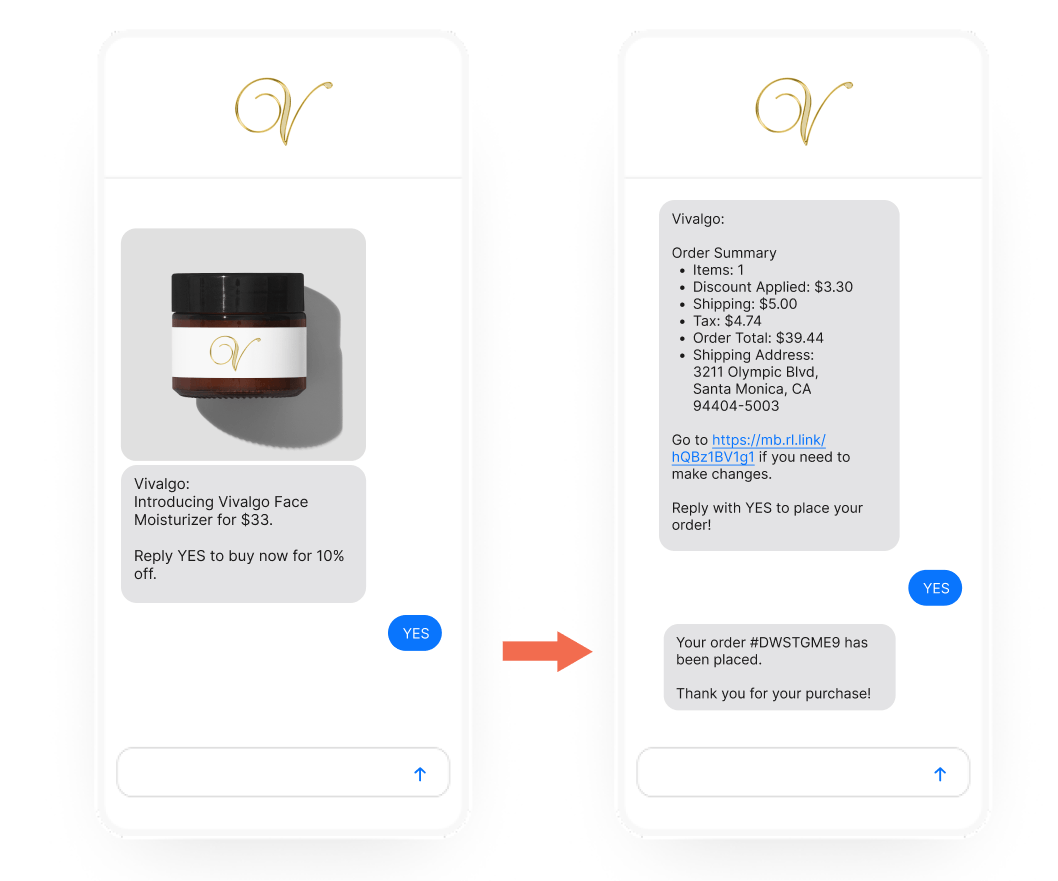Learn more on www.bloomreach.com >
What Is Conversational Commerce?

Imagine the following scenarios:
- You are on the run, and you get an SMS to reorder the face cream you are running out of, and you are able to complete your order with 2 simple “clicks”.
- You are looking at a product on the website and want to know if it will arrive in time for your upcoming flight, and you are able to get your question answered on Messenger by an agent who also helps you complete your transaction seamlessly.
- Product packaging on your energy bar has a keyword to text or a QR code to scan, and you are able to reorder or manage your subscription for the bar in SMS without ever needing to login on a website.
Conversational commerce is the
process of buying goods and services over messaging channels like Messenger, SMS, Instagram Messaging, and WhatsApp. In the post-pandemic world, mobile commerce is booming (for more than 70% of the users, mobile phones are their primary device), but the friction in mobile commerce is still high. Conversational commerce helps remove a lot of the friction out of mobile commerce.
Chris Messina coined the phrase “conversational commerce” back in 2015. Over the years, the term has been broadly applied to any conversations, automated or agent driven, between the user and an ecommerce brand. It has included both marketing related and customer service related conversations. The automated part of conversational commerce has often been referred to by the term chatbots.
Until recently, the actual act of placing the order didn’t happen inside the messaging channel because of payment and API limitations. Instead, the users were directed to the website for the actual ordering. We are mostly referring to the US market here and to solutions that are broadly available to ecommerce merchants. There have been some notable examples of checkout happening in messaging, but they have mostly been one-offs.
This fundamental limitation is now changing, and our thesis is that
conversational checkout is going to go mass market because of its simplicity and ease of use. We believe that over time the definition of Conversational Commerce will evolve to focus more on enabling the checkout/transaction through messaging. Of course, checkout doesn’t live in a vacuum - conversational commerce includes the user journey before checkout as well as the user journey after checkout.
Conversational Commerce Use Cases
Messaging channels like SMS, Messenger, and WhatsApp are more than just communication channels. The always logged-in identity and interactivity, the two superpowers of messaging, can be used to turn these channels into frictionless front-ends for ecommerce.
Here are some examples of how brands can use conversational commerce today:
- Send reorder and upsell notifications in SMS and other messaging channels with simple flows to complete the transaction in messaging.
- Enable users to view their purchase history and even reorder previously purchased products in the bot, without having to go to the website.
- Provide easy ways for the user to ask questions over SMS (from marketing notifications, website, and emails etc.) and enable the agents to answer questions and also assist with the checkout if needed.
- Allow users to check the status of their previously placed orders.
- Enable users to manage their subscriptions e.g. skip or delay shipments or add/remove products from upcoming shipments.
Benefits of Conversational Commerce
We all know how popular messaging channels like SMS, Messenger, and WhatsApp are for user to user communication. In the last few years, as more and more users have gone mobile in the US, these channels have started to emerge as the preferred channels for business to user communications and interactions, especially for ecommerce brands. This trend has been going on for even longer in Asia.
Here are 3 key reasons why brands are embracing Conversational Commerce:
- High level of user engagement: users love these channels and spend much more time on them compared to email. This is borne out in the metrics - 95% message open rates, 30% reply rates, 2X conversion rates.
- Frictionless checkout and other identity-driven ecommerce operations: the always logged-in identity (SMS number or FB id) and interactivity of these channels allow identity drive operations like checkout, order status checks, subscription management etc. to be performed without much friction.
- Full life-cycle engagement: messaging is the only channel where brands can engage users throughout the ecommerce customer journey - marketing, interactions, checkout, and customer support. This avoids having to switch users from one channel to another (e.g. email to website and provides a seamless customer experience.
Final Thoughts
Conversational Commerce is changing the face of mobile commerce. Learn more here:
- How Conversational Checkout Can Boost Ecommerce Sales
- 5 Best Practices for Conversational Checkout
- Role of Live Agents in Conversational Commerce

